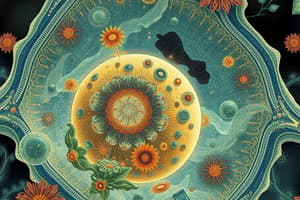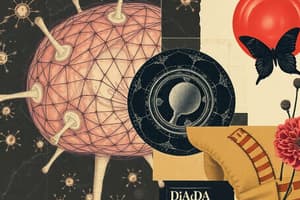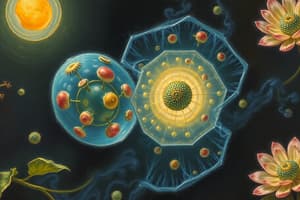Podcast
Questions and Answers
Which of the following is NOT considered a core principle of biology?
Which of the following is NOT considered a core principle of biology?
- Cell theory
- Gene theory
- Ecosystem dynamics (correct)
- Homeostasis
What defines the process of evolution?
What defines the process of evolution?
- The development of an individual organism over its lifespan.
- The cyclical changes within an ecosystem.
- The change in genetic characteristics of a population over generations. (correct)
- The immediate response of an organism to environmental stress.
What is the fundamental concept of cell theory?
What is the fundamental concept of cell theory?
- The cell is the basic unit of life. (correct)
- All cells have a nucleus.
- Cells are not present in all living organisms.
- Cells can only be created in a laboratory.
Which of the following best describes homeostasis?
Which of the following best describes homeostasis?
What role do mutations play in the process of evolution?
What role do mutations play in the process of evolution?
How does gene flow affect genetic variation between populations?
How does gene flow affect genetic variation between populations?
Which of the following is an example of a vestigial structure?
Which of the following is an example of a vestigial structure?
What information can be derived from comparing DNA sequences between different species?
What information can be derived from comparing DNA sequences between different species?
What is the primary difference between allopatric and sympatric speciation?
What is the primary difference between allopatric and sympatric speciation?
Which factor primarily drives adaptive radiation?
Which factor primarily drives adaptive radiation?
How do phylogenetic trees depict evolutionary relationships?
How do phylogenetic trees depict evolutionary relationships?
What does the fossil record primarily provide evidence of?
What does the fossil record primarily provide evidence of?
What is the evolutionary significance of the Cambrian explosion?
What is the evolutionary significance of the Cambrian explosion?
How can understanding evolution be useful in addressing antibiotic resistance?
How can understanding evolution be useful in addressing antibiotic resistance?
Which of the following contributes to sympatric speciation?
Which of the following contributes to sympatric speciation?
What is the evolutionary consequence of mass extinction events?
What is the evolutionary consequence of mass extinction events?
How does the concept of 'descent with modification' relate to the study of evolution?
How does the concept of 'descent with modification' relate to the study of evolution?
What is the significance of conserved genes in evolutionary studies?
What is the significance of conserved genes in evolutionary studies?
How does biogeography contribute to our understanding of evolution?
How does biogeography contribute to our understanding of evolution?
What distinguishes homologous structures from analogous structures?
What distinguishes homologous structures from analogous structures?
What is the role of genetic drift in small populations?
What is the role of genetic drift in small populations?
How does the study of molecular biology support the theory of evolution?
How does the study of molecular biology support the theory of evolution?
Which of the following is true concerning the origin of life?
Which of the following is true concerning the origin of life?
A population of birds colonizes a newly formed volcanic island. Initially, the population consists mostly of birds with average-sized beaks, suitable for eating the available seeds. Over time, a new plant species with very large, hard seeds colonizes the island. Birds with larger beaks are more efficient at cracking these seeds. What do you predict will happen to the bird population over many generations?
A population of birds colonizes a newly formed volcanic island. Initially, the population consists mostly of birds with average-sized beaks, suitable for eating the available seeds. Over time, a new plant species with very large, hard seeds colonizes the island. Birds with larger beaks are more efficient at cracking these seeds. What do you predict will happen to the bird population over many generations?
Which of the following scenarios describes allopatric speciation?
Which of the following scenarios describes allopatric speciation?
Organisms maintain internal equilibrium through regulatory mechanisms. Which is NOT an example of the regulatory or feedback mechanisms related to homeostasis?
Organisms maintain internal equilibrium through regulatory mechanisms. Which is NOT an example of the regulatory or feedback mechanisms related to homeostasis?
A small population of lizards lives on an island. A hurricane drastically reduces the population size. By chance, the allele for green skin becomes more common, and the allele for brown skin becomes rarer. Which evolutionary mechanism is at play?
A small population of lizards lives on an island. A hurricane drastically reduces the population size. By chance, the allele for green skin becomes more common, and the allele for brown skin becomes rarer. Which evolutionary mechanism is at play?
Which of the following is an example of analogous structures?
Which of the following is an example of analogous structures?
A scientist compares the DNA sequences of several closely related species of bacteria. She notices that certain genes are nearly identical across all species. What can she infer about these genes?
A scientist compares the DNA sequences of several closely related species of bacteria. She notices that certain genes are nearly identical across all species. What can she infer about these genes?
What is the primary effect of gene flow between two populations?
What is the primary effect of gene flow between two populations?
The phylogenetic tree shows a polytomy. What does this indicate?
The phylogenetic tree shows a polytomy. What does this indicate?
Which condition is absolutely required for natural selection to occur in a population?
Which condition is absolutely required for natural selection to occur in a population?
A biologist is studying a population of butterflies with traits that appear to be in Hardy-Weinberg equilibrium. Which statement best describes this population?
A biologist is studying a population of butterflies with traits that appear to be in Hardy-Weinberg equilibrium. Which statement best describes this population?
During which geologic period did the Cambrian explosion, a period of rapid diversification of life, occur?
During which geologic period did the Cambrian explosion, a period of rapid diversification of life, occur?
Anabolic steroids are sometimes used by athletes to enhance muscle growth. Why is this not considered evolution?
Anabolic steroids are sometimes used by athletes to enhance muscle growth. Why is this not considered evolution?
Consider a hypothetical scenario: a population of brightly colored birds exists on an island. A disease outbreak selectively kills birds with a specific genetic marker linked to the brightest plumage. Over generations, the average brightness of the bird plumage declines. Later, a group of birds from a different island, with genetically diverse and equally bright plumage, migrates to the first island and interbreeds. What is the most likely long-term effect on the original bird population's genetic makeup?
Consider a hypothetical scenario: a population of brightly colored birds exists on an island. A disease outbreak selectively kills birds with a specific genetic marker linked to the brightest plumage. Over generations, the average brightness of the bird plumage declines. Later, a group of birds from a different island, with genetically diverse and equally bright plumage, migrates to the first island and interbreeds. What is the most likely long-term effect on the original bird population's genetic makeup?
Flashcards
What is Biology?
What is Biology?
The scientific study of life, examining structure, function, growth, origin, evolution, distribution, and taxonomy.
What is Evolution?
What is Evolution?
Change in heritable characteristics of biological populations over successive generations.
What is Cell Theory?
What is Cell Theory?
The cell is the basic unit of life.
What is Gene Theory?
What is Gene Theory?
Signup and view all the flashcards
What is Homeostasis?
What is Homeostasis?
Signup and view all the flashcards
Explain Evolution
Explain Evolution
Signup and view all the flashcards
What is Natural Selection?
What is Natural Selection?
Signup and view all the flashcards
What are Mutations?
What are Mutations?
Signup and view all the flashcards
What is Genetic Drift?
What is Genetic Drift?
Signup and view all the flashcards
What is Gene Flow?
What is Gene Flow?
Signup and view all the flashcards
What do Fossil Records provide?
What do Fossil Records provide?
Signup and view all the flashcards
What does Comparative Anatomy reveal?
What does Comparative Anatomy reveal?
Signup and view all the flashcards
What does Molecular Biology show?
What does Molecular Biology show?
Signup and view all the flashcards
What does Biogeography study?
What does Biogeography study?
Signup and view all the flashcards
What are Fossils?
What are Fossils?
Signup and view all the flashcards
What are Homologous Structures?
What are Homologous Structures?
Signup and view all the flashcards
What are Analogous Structures?
What are Analogous Structures?
Signup and view all the flashcards
What are Vestigial Structures?
What are Vestigial Structures?
Signup and view all the flashcards
What can DNA and protein sequences indicate?
What can DNA and protein sequences indicate?
Signup and view all the flashcards
What are Endemic Species?
What are Endemic Species?
Signup and view all the flashcards
What is Speciation?
What is Speciation?
Signup and view all the flashcards
What is Allopatric Speciation?
What is Allopatric Speciation?
Signup and view all the flashcards
What is Sympatric Speciation?
What is Sympatric Speciation?
Signup and view all the flashcards
What is Polyploidy?
What is Polyploidy?
Signup and view all the flashcards
What are Phylogenetic Trees?
What are Phylogenetic Trees?
Signup and view all the flashcards
What is Abiogenesis?
What is Abiogenesis?
Signup and view all the flashcards
What did the evolution of Photosynthesis allow?
What did the evolution of Photosynthesis allow?
Signup and view all the flashcards
What was the Cambrian Explosion?
What was the Cambrian Explosion?
Signup and view all the flashcards
What are Mass Extinctions?
What are Mass Extinctions?
Signup and view all the flashcards
What is Adaptive Radiation?
What is Adaptive Radiation?
Signup and view all the flashcards
How does antibiotic resistance evolve?
How does antibiotic resistance evolve?
Signup and view all the flashcards
Study Notes
- Biology is the scientific study of life, examining the structure, function, growth, origin, evolution, distribution, and taxonomy of living organisms.
- Evolution is the change in the heritable characteristics of biological populations over successive generations.
Core Principles of Biology
- Cell theory: The cell is the basic unit of life.
- Gene theory: DNA is the fundamental hereditary material.
- Homeostasis: Living organisms maintain a stable internal environment.
- Evolution accounts for the unity and diversity of life.
Cell Theory
- All living organisms are composed of one or more cells.
- The cell is the basic unit of structure and function in organisms.
- All cells arise from pre-existing cells.
Gene Theory
- Genes, composed of DNA, are the basic units of heredity.
- Genes encode the information necessary to synthesize proteins and other essential molecules.
- Genes are passed from parents to offspring, influencing the traits of the offspring.
Homeostasis
- Organisms maintain a stable internal environment despite changes in the external environment.
- Homeostatic mechanisms involve feedback loops that regulate various physiological processes.
- Examples of homeostasis include temperature regulation, pH balance, and glucose concentration.
Evolution
- Evolution is the process by which populations of organisms change over time.
- These changes are heritable and passed on through genes.
- Evolution is driven by mechanisms such as natural selection, mutation, genetic drift, and gene flow.
Natural Selection
- Natural selection is a key mechanism of evolution.
- Individuals with traits better suited to their environment are more likely to survive and reproduce.
- These advantageous traits become more common in the population over time.
Mutation
- Mutations are changes in the DNA sequence that can introduce new traits.
- Mutations can be spontaneous or caused by environmental factors.
- Mutations provide the genetic variation upon which natural selection acts.
Genetic Drift
- Genetic drift refers to random changes in the frequency of traits in a population.
- It is more pronounced in small populations.
- Genetic drift can lead to the loss of genetic variation.
Gene Flow
- Gene flow is the movement of genes between populations.
- It can introduce new genetic variation into a population.
- Gene flow can reduce genetic differences between populations.
Evidence of Evolution
- Fossil records provide evidence of past life forms and their transitions.
- Comparative anatomy reveals similarities in the structures of different organisms.
- Molecular biology shows the relatedness of organisms through their DNA and proteins.
- Biogeography studies the distribution of species and how they have evolved in different environments.
Fossil Records
- Fossils are the preserved remains or traces of ancient organisms.
- They provide a chronological record of life's history.
- Fossils can show the intermediate forms of organisms, illustrating evolutionary transitions.
Comparative Anatomy
- Homologous structures are anatomical features that have a common evolutionary origin, even if they have different functions.
- Analogous structures are features that have similar functions but evolved independently.
- Vestigial structures are remnants of organs or structures that had a function in an ancestor but no longer do.
Molecular Biology
- DNA and protein sequences can be compared to determine the relatedness of different species.
- Closely related species have more similar DNA sequences.
- Conserved genes are genes that have remained relatively unchanged throughout evolutionary history, indicating their importance.
Biogeography
- The distribution of species around the world reflects their evolutionary history and the movement of continents.
- Endemic species are found only in a specific geographic area.
- Islands often have unique species that have evolved in isolation.
Speciation
- Speciation is the process by which new species arise.
- Allopatric speciation occurs when populations are separated by a physical barrier.
- Sympatric speciation occurs when new species arise within the same geographic area.
Allopatric Speciation
- A population is divided by a geographic barrier, such as a mountain range or body of water.
- The separated populations evolve independently due to different environmental conditions and genetic drift.
- Over time, the populations become so different that they can no longer interbreed.
Sympatric Speciation
- New species can arise within the same geographic area through mechanisms such as polyploidy, habitat differentiation, or sexual selection.
- Polyploidy is the duplication of chromosomes, which can lead to reproductive isolation.
- Habitat differentiation occurs when subpopulations within the same area use different resources.
- Sexual selection can drive the evolution of different mating behaviors or preferences.
Phylogenetic Trees
- Phylogenetic trees are diagrams that show the evolutionary relationships among organisms.
- They are based on shared characteristics, such as anatomical features or DNA sequences.
- Each branch point on the tree represents a common ancestor.
Evolutionary History
- The history of life on Earth has been marked by major evolutionary events, such as the origin of life, the evolution of photosynthesis, and the Cambrian explosion.
- Mass extinction events have also played a role in shaping the diversity of life.
Origin of Life
- Life is thought to have originated from non-living matter through a process called abiogenesis.
- The early Earth had different atmospheric conditions.
- Key steps in the origin of life may have included the formation of organic molecules, the assembly of polymers, and the formation of protocells.
Photosynthesis
- The evolution of photosynthesis allowed organisms to harness energy from the sun.
- This led to an increase in the amount of oxygen in the atmosphere.
- Oxygen-rich atmosphere supported the evolution of more complex life forms
Cambrian Explosion
- The Cambrian explosion was a period of rapid diversification of life.
- Many new types of animals appeared in a relatively short amount of time.
- This event may have been triggered by changes in environmental conditions or the evolution of new developmental genes.
Mass Extinctions
- Mass extinctions are events in which a large percentage of species on Earth go extinct in a relatively short amount of time.
- They can be caused by factors such as asteroid impacts, volcanic eruptions, or climate change.
- Mass extinctions can create new opportunities for the surviving species, leading to adaptive radiation.
Adaptive Radiation
- Adaptive radiation is the rapid diversification of a lineage into many different forms.
- It often occurs after a mass extinction event.
- The surviving species can evolve to fill the ecological niches left vacant by the extinct species.
Evolution and Human Health
- Understanding evolution is important for addressing many human health issues, such as antibiotic resistance, the evolution of viruses, and the development of new drugs.
- Antibiotic resistance evolves when bacteria are exposed to antibiotics, those that are resistant survive and reproduce, leading to a population of resistant bacteria.
- Viruses can evolve rapidly, making it difficult to develop effective vaccines and treatments.
- The study of evolution can provide insights into the development of new drugs that target specific molecules or pathways in disease-causing organisms.
Studying That Suits You
Use AI to generate personalized quizzes and flashcards to suit your learning preferences.




